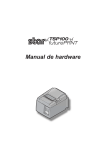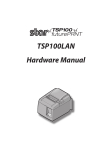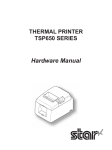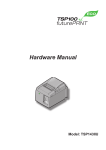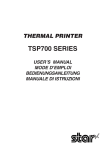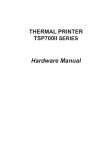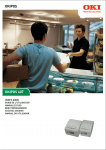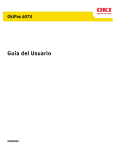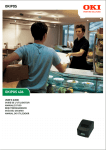Download Star Micronics FUTUREPRINT TSP100 User's Manual
Transcript
Hardware Manual Federal Communications Commission Radio Frequency Interference Statement This equipment has been tested and found to comply with the limits for a Class A digital device, pursuant to Part 15 of the FCC Rules. These limits are designed to provide reasonable protection against harmful interference when the equipment is operated in a commercial environment. This equipment generates, uses and can radiate radio frequency energy and, if not installed and used in accordance with the instruction manual, may cause harmful interference to radio communications. Operation of this equipment in a residential area is likely to cause harmful interference in which case the user will be required to correct the interference at his own expense. For compliance with the Federal Noise Interference Standard, this equipment requires a shielded cable. This statement will be applied only for the printers marketed in U.S.A. Statement of The Canadian Department of Communications Radio Interference Regulations This digital apparatus does not exceed the Class A limits for radio noise emissions from digital apparatus set out in the Radio Interference Regulations of the Canadian Department of Communications. Le présent appareil numérique n’émet pas de bruits radioélectriques dépassant les limites applicables aux appareils numériques de la classe A prescrites dans le Règlement sur le brouillage radioélectrique édicté par le ministère des Communications du Canada. The above statement applies only to printers marketed in Canada. CE Manufacturer’s Declaration of Conformity EC Council Directive 89/336/EEC of 3 May 1989 This product, has been designed and manufactured in accordance with the International Standards EN 61000-6-3 / 2001 and EN 55024 / 1998, following the provisions of the Electro Magnetic Compatibility Directive of the European Communities as of May 1989. EC Council Directive 73/23/EEC and 93/68/EEC of 22 July 1993 This product, has been designed and manufactured in accordance with the International Standards EN 60950-1, following the provisions of the Low Voltage Directive of the European Communities as of 2001. The above statement applies only to printers marketed in EU. Trademark acknowledgments TSP100: Star Micronics Co., Ltd. Notice • All rights reserved. Reproduction of any part of this manual in any form whatsoever, without STAR’s express permission is forbidden. • The contents of this manual are subject to change without notice. • All efforts have been made to ensure the accuracy of the contents of this manual at the time of going to press. However, should any errors be detected, STAR would greatly appreciate being informed of them. • The above notwithstanding, STAR can assume no responsibility for any errors in this manual. © Copyright 2005 Star Micronics Co., LTD. TABLE OF CONTENTS 1. Unpacking and Installation ..........................................................................1 1-1.Unpacking ...........................................................................................1 2. Parts Identification and Nomenclature ......................................................2 3. Setup ...............................................................................................................5 3-1.Connecting the USB Cable to the Printer ............................................5 3-2.Connecting to a Peripheral Unit .......................................................... 6 3-3.Loading the Roll Paper ........................................................................ 7 3-4.Connecting the USB Cable to the PC ................................................ 10 3-5.Installing the Printer Software ........................................................... 10 3-6.Connecting the Power Cord ..............................................................11 3-7.Turning Power On .............................................................................12 4. Attaching the Accessories ...........................................................................13 4-1.Attaching the Holder Plate ................................................................13 4-2.Attaching the Rubber Feet .................................................................14 4-3.Switch Blind Installation ................................................................... 15 5. Termal Roll Paper Specification ...............................................................16 6. Control Panel and Other Functions .......................................................... 17 6-1.Control Panel ..................................................................................... 17 6-2.Errors .................................................................................................17 6-3.Self-Printing ......................................................................................19 7. Preventing and Clearing Paper Jams ....................................................... 20 7-1.Preventing Paper Jams....................................................................... 20 7-2.Removing Paper Jam ......................................................................... 20 7-3.Releasing a Locked Cutter (Auto Cutter Mode only) ....................... 21 8. Periodical Cleaning ..................................................................................... 23 8-1.Cleaning the Thermal Head ...............................................................23 8-2.Cleaning the Paper Holder ................................................................23 9. Periheral Unit Drive Circuit ...................................................................... 24 10. Specifications ............................................................................................... 26 10-1.General Specifications ....................................................................... 26 10-2.Auto Cutter Specifications ................................................................27 10-3.Interface ............................................................................................. 27 10-4.Electrical Characteristics ................................................................... 27 10-5.Environmental Requirements ............................................................ 27 10-6.Reliability ..........................................................................................28 Please access the following URL http://www.star-m.jp/eng/dl/dl02.htm for the lastest revision of the manual. 1. Unpacking and Installation 1-1. Unpacking After unpacking the unit, check that all the necessary accessories are included in the package. USB cable Switch blind Power cord Paper roll holder Screws Ferrite core Rubber foots CD-ROM Holder plate Setup sheet Printer Roll paper Fig. 1-1 Unpacking If anything is missing, contact the dealer where you bought the printer and ask them to supply the missing part. Note that it is a good idea to keep the original box and all the packing materials just in case you need to pack the printer up again and send it somewhere at a later date. –1– 2. Parts Identification and Nomenclature Auto Cutter Model Printer cover Open this cover to load or replace paper. Cover open lever Pull this lever in the direction of the arrow to open the printer cover. Power switch Used to turn on/off power to the printer. Control panel Features LED indicators to indicate printer status and switches to operate the printer. Interface connector For connection to a host computer. Peripheral drive connector Connects to peripheral units such as cash drawers, etc. Do not connect this to a telephone. –2– Power connector For connection of the power cord. Tear Bar Model Printer cover Open this cover to load or replace paper. Cover open lever Pull this lever in the direction of the arrow to open the printer cover. Power switch Control panel Used to turn on/off power to the printer. Features LED indicators to indicate printer status and switches to operate the printer. Interface connector For connection to a host computer. Peripheral drive connector Connects to peripheral units such as cash drawers, etc. Do not connect this to a telephone. –3– Power connector For connection of the power cord. Choosing a place for the printer Before actually unpacking the printer, you should take a few minutes to think about where you plan to use it. Remember the following points when doing this. ✓ Choose a firm, level surface where the printer will not be exposed to vibration. ✓ The power outlet you plan to connect to for power should be nearby and unobstructed. ✓ Make sure that the printer is close enough to your host computer for you to connect the two. ✓ Make sure that the printer is not exposed to direct sunlight. ✓ Make sure that the printer is well away from heaters and other sources of extreme heat. ✓ Make sure that the surrounding area is clean, dry, and free of dust. ✓ Make sure that the printer is connected to a reliable power outlet. It should not be on the same electric circuit as copiers, refrigerators, or other appliances that cause power spikes. ✓ Make sure that the room where you are using the printer is not too humid. WARNING ✓ Shut down your equipment immediately if it produces smoke, a strange odor, or unusual noise. Immediately unplug the equipment and contact your dealer for advice. ✓ Never attempt to repair this product yourself. Improper repair work can be dangerous. ✓ Never disassemble or modify this product. Tampering with this product may result in injury, fire, or electric shock. –4– 3. Setup 3-1. Connecting the USB Cable to the Printer Affix the ferrite core onto the USB interface cable and pass the cable through the cable support as shown. Then, connect the USB interface cable to the printer. Note: The dialog shown below may appear on your PC screen if your PC is running Windows 98 or Me, and if you turn ON the power of the printer for the first time while the PC and the printer are connected with the USB cable. In this case, refer to the software manual on the CD-ROM, in the following directory: Documents folder. –5– 3-2. Connecting to a Peripheral Unit You can connect a peripheral unit to the printer using a modular plug. The following describes how to install the ferrite core and make the actual connection. See “Modular plug” on page 24 for details about the type of modular plug that is required. Note that this printer does not come with a modular plug or wire, so it is up to you to obtain one that suits your needs. CAUTION Make sure that the printer is turned off and unplugged from the AC outlet and that the computer is turned off before making connections. (1) Connect the peripheral drive cable to the connector on the rear panel of the printer. CAUTION Do not connect a telephone line into the peripheral drive connector. Failure to observe this may result in damage to the printer. Also, for safety purposes, do not connect wiring to the external drive connector if there is a chance it may carry peripheral voltage. –6– 3-3. Loading the Roll Paper Be sure to use roll paper that matches the printer’s specification. When using a paper roll with an 57.5 mm width, install the paper roll holder as described on the following page. Cover open lever Roll paper 1) Push the cover open lever, and open the printer cover. 2) While observing the direction of the roll, set the paper roll into the hollow, and pull on the leading edge of the paper toward you. –7– Note: When using a paper roll with an 57.5 mm width, install the paper roll holder in the groove in the printer. If a paper roll with a 57.5 mm width has been used, a paper roll with a 79.5 mm width cannot be used. (Changing from the smaller roll to a larger roll will cause part of the print head to rub against the platen and deteriorate.) Paper roll holder 3) Push down both sides of the printer cover to close. Note: Make sure that the printer cover is securely closed. 4) Tear Bar Model: Tear off the paper as shown. Auto Cutter Model: If the printer cover is closed after turning on the power, the cutter operates automatically and the front end of the paper is cut. Tear Bar Model –8– WARNING • Do not touch the cutter blade. - There is a cutter inside the paper outlet slot. Not only should you not put your hand in the paper outlet slot while printing is in progress, never put your hand into the outlet even when printing is not in progress. - The printer cover can be opened when replacing the paper. However, since the cutter blade is on the inside of the printer cover, be careful not to place your face or hands too close to the cutter blade. • During and immediately after printing, the area around the thermal head is very hot. Do not touch it, as you could be burned. CAUTION • Do not operate the cover open lever while pressing on the printer cover with your hand. • Do not pull the cover open lever and open the printer cover when printing is in progress or when the auto cutter is operating. • Do not pull out paper while the printer cover is closed. • The heating element and the driver IC of the thermal head are easily damaged. Do not touch them with metal objects, sandpaper, etc. • Printing quality may suffer if the thermal head heating element becomes soiled by being touched with your hands. Do not touch the thermal head heating element. • There is a risk of damage to the driver IC of the thermal head from static electricity. Never directly touch the IC. • The printing quality and working life of the thermal head cannot be guaranteed if any paper other than that recommended is used. In particular, paper containing [Na+, K+, C1-] may drastically reduce the working life of the thermal head. Please exercise caution. • Do not operate the printer if there is moisture on the front surface of the head from condensation, etc. –9– 3-4. Connecting the USB Cable to the PC Connect the USB interface cable to a USB port of your PC. Note: The dialog shown below may appear on your PC screen if your PC is running Windows 98 or Me, and if you turn ON the power of the printer for the first time while the PC and the printer are connected with the USB cable. In this case, refer to the software manual on the CD-ROM, in the following directory: Documents folder. 3-5. Installing the Printer Software Here is the procedure for installing the printer driver and utility software, which are stored on the supplied CD-ROM. The procedure applies to the Windows operating systems shown below. For instructions on the Linux and Macintosh OS X, refer to the software manual located in the “Linux” and “Mac” folders on the CD-ROM. · Windows 98 SE · Windows 2000 · Windows Me · Windows XP (1) Turn ON the power to your PC to start Windows. (2) Insert the supplied CD-ROM (Drivers and Utilities) into the CD-ROM drive. (3) Follow the instructions that appear on the screen. (4) The dialog shown in the illustration indicates that the procedure has been completed. Click “OK”. The dialog that appears on the screen varies with your system. This completes the installation of the printer software. A message will appear, prompting you to restart. Restart Windows. – 10 – 3-6. Connecting the Power Cord Note: Before connecting/disconnecting the power cord, make sure that power to the printer and all the devices connected to the printer is turned off. Also make sure the power cable plug is disconnected from the AC outlet. (1) Check the label on the back or bottom of the printer to make sure its voltage matches that of the AC outlet. Also make sure the plug on the power cord matches the AC outlet. (2) If the power cord is not attached to the printer, plug the appropriate end into the AC inlet on the back of the printer. (3) Plug the power cord into a properly grounded AC outlet. CAUTION If the voltage shown on the label on the of your printer does not match the voltage for your area, contact your dealer immediately. – 11 – 3-7. Turning Power On Make sure that the Power cord has been connected as described in 3-6. (1) Turn ON the power switch located on the front of the printer. The POWER lamp on the control panel will light up. Power switch CAUTION We recommend that you unplug the printer from the power outlet whenever you do not plan to use it for long periods. Because of this, you should locate the printer so that the power outlet it is plugged into is nearby and easy to access. When an Switch blind is affixed to the printer above the power switch, the ON/OFF marks of the power switch may be hidden. If this occurs, remove the power cord from the outlet to turn the printer OFF. Note: The dialog shown below may appear on your PC screen if your PC is running Windows 98 or Me, and if you turn ON the power of the printer for the first time while the PC and the printer are connected with the USB cable. In this case, refer to the software manual on the CD-ROM, in the following directory: Documents folder. – 12 – 4. Attaching the Accessories 4-1. Attaching the Holder Plate (1) Attach the holding plate to the printer. Then tighten the two screws that were supplied to secure it in place. (2) Position the printer over the wall bracket and then slide it downward to set it in place. The printer is fixed in place by interlocking the hook on the plate attached to the bottom of the printer with the hook connector on the bracket. It is not necessary to secure it further with screws. To purchase a bracket, which is sold separately, please contact your dealer. (3) Push the cover open lever, and open the printer cover. (4) Insert the roll paper as shown. – 13 – 4-2. Attaching the Rubber Feet (1) Attach the four rubber feet in the positions shown in the figure. Ensure that any soiling has been completely wiped off before attaching the rubber feet. (2) Push the cover open lever, and open the printer cover. (3) Insert the roll paper as shown. – 14 – 4-3. Switch Blind Installation It is not necessary to install the switch blind. Only install it if it is necessary for you. By installing the switch blind, the following become possible. • Preventing the power switch from being operated by mistake. • Ensuring that other people can not easily operate the power switch. Install the switch blind as shown in the diagram below. The power switch can be turned ON (!) and OFF (O) by inserting a narrow instrument (ball pen etc.) in the holes in the switch blind. CAUTION We recommend that you unplug the printer from the power outlet whenever you do not plan to use it for long periods. Because of this, you should locate the printer so that the power outlet it is plugged into is nearby and easy to access. – 15 – 5. Termal Roll Paper Specification When consumable parts have run out, use those specified below. (1) Roll paper specification Thermal paper Thickness: 65~85 µm (excluding Mitsubishi HiTec F5041) Width: 79.5±0.5 mm (57.5±0.5 mm when the paper roller holder is used) Outer roll diameter: ø83 mm or less +0.5 -1 mm or (58 -1 mm when the Take up paper roll width: 80 +0.5 paper roller holder is used) Core outer/inner diameter Core outer Core inner ø18±1 mm ø12±1 mm Printed surface: Outer edge of roll Tail end handling: Do not use paste or glue to secure the roll paper or its core. Do not fold the tail end of the paper. (2) Recommended paper Mitsubishi Paper Mills Limited P220AG (normal type paper), 65 µm (thickness) HP220AB-1 (high image stability paper), 75 µm (thickness) PB670 (2 color paper: Red & Black), 75 µm (thickness) PB770 (2 color paper: Blue & Black), 75 µm (thickness) Mitsubishi HiTec Paper Flensburg GmbH F5041 (normal type paper), 60 µm (thickness) Oji Paper Co., Ltd. PD150R (normal type paper), 75 µm (thickness) PD160R (high image stability paper), 65/75 µm (thickness) PD750R (2 color paper: Red & Black), 75 µm (thickness) PD700R (2 color paper: Blue & Black), 75 µm (thickness) Nippon Paper Industries TF50KS-E2C (normal type paper), 65 µm (thickness) Kanzaki Specialty Papers Inc. (KSP) P320RB (2 color paper: Red & Black), 65 µm (thickness) P320BB (2 color paper: Blue & Black), 65 µm (thickness) Note: Access the following URL for the information of the recommended paper. http://www.star-m.jp/eng/dl/dl02.htm – 16 – 6. Control Panel and Other Functions 6-1. Control Panel 1 POWER lamp (Green LED) Lights when the power is ON. 2 ERROR lamp (Red LED) Indicates various errors in combination with POWER lamp. 3 FEED button 2 ERROR lamp (Red LED) 1 POWER lamp (Green LED) 3 FEED button Press the FEED button to feed roll paper. 6-2. Errors 1) Automatically recoverable errors Error Description POWER Lamp ERROR Lamp Recovery Conditions Head high temperature detection Flashes at 0.5second intervals Off Automatically recovered after the print head has cooled. Board high temperature detection Flashes at 2second intervals Off Automatically recovered after the board has cooled. Cover open error On On Automatically recovered after the printer cover is closed. – 17 – 2) Non-recoverable errors Error Description POWER Lamp ERROR Lamp Recovery Conditions Head thermistor error Flashes at 0.5second intervals Flashes at 0.5second intervals Non-recoverable Board thermistor error Flashes at 2second intervals Flashes at 2second intervals Non-recoverable VM voltage error Off Flashes at 1second intervals Non-recoverable VCC voltage error Flashes at 1second intervals Flashes at 1second intervals Non-recoverable EEPROM error Flashes at 0.25second intervals Flashes at 0.25second intervals Non-recoverable USB error Flashes at 5second intervals Flashes at 5second intervals Non-recoverable CPU error Off Off Non-recoverable RAM error Off On Non-recoverable Note: 1) If a non-recoverable error occurs, turn the power OFF immediately. 2) If a non-recoverable error occurs, please consult the dealer for repairs. 3) Paper cut error Error Description POWER Lamp ERROR Lamp Recovery Conditions Paper cut error Off Flashes at 0.125second intervals Recovered by turning the power OFF, eliminating the cause of the error such as jammed paper, returning the cutter to its home position, and turning the power ON (see 7-3). Note: If the cutter does not return to its home position or does not perform the initial movement, it will result in a non-recoverable error. 4) Paper detection error Error Description POWER Lamp ERROR Lamp Recovery Conditions Paper out error On Flashes at 0.5second intervals Automatically recovered by loading a new paper roll, then closing the printer cover. – 18 – 6-3. Self-Printing Test Printing Turn the power ON while holding the FEED button depressed. The printer will run a test print according to the Ver. No., DIP switch settings, and character order. After the printer starts printing, release your hand from the FEED button. After self-printing is completed, the printer will start in the normal mode. – 19 – 7. Preventing and Clearing Paper Jams 7-1. Preventing Paper Jams The paper should not be touched during ejection and before it is cut. Pressing or pulling the paper during ejection may cause a paper jam, paper cutting failure or line feed failure. 7-2. Removing Paper Jam If a paper jam occurs, clear it as described below. (1) Set the power switch to off to turn off power to the printer. (2) Push the cover open lever, and open the printer cover. If the printer cover will not open on auto cutter models, it means that the auto cutter is not at the home position. In this case, return the auto cutter to the home position by following the instructions provided in section 7-3. Then open the printer cover after the paper jam has been removed. (3) Remove the jammed paper. CAUTION Take care not to damage the printer when removing the jammed paper. Since it is easy to damage the thermal head in particular, take care not to touch it. (4) Position the roll paper straight and close the printer cover gently. Note 1: Make sure that the paper is positioned straight. If the printer cover is closed with the paper skewed, a paper jam may result. Note 2: Lock the printer cover by pressing down on the sides. Do not try to close it by pressing down on the center. The cover may not lock properly. (5) Set the power switch to on to turn on power to the printer. Make sure that the ERROR LED is not lit. Note: While the ERROR LED is lit, the printer will not accept any commands such as the print command, so make sure that the printer cover is locked properly. – 20 – 7-3. Releasing a Locked Cutter (Auto Cutter Mode only) If the auto cutter locks up or fails to cut the paper, follow the steps below. WARNING Since working on the cutter may be dangerous, be sure to turn off the printer first. (1) Set the power switch to OFF to turn off the printer. (2) Remove the front cover to reveal the auto cutter. (3) Remove any jammed paper. Note: Be careful not to damage the printer while removing any jammed paper. Since the thermal print head is particularly sensitive, be sure not to touch it. Front cover Auto cutter – 21 – (4) If the cutter is locked, insert a Philips screwdriver into the Philips screw hole on the side of the cutter, and turn it in the direction of the arrow shown on the right, in order to return the cutter to its normal position. (5) Open the printer cover, remove any jammed paper, and then reinstall the paper roll. (6) Install the front cover, and then set the power switch to ON. – 22 – 8. Periodical Cleaning Printed characters may become partially unclear due to accumulated paper dust and dirt. To prevent such a problem, paper dust collected in the paper holder and paper transport section and on the surface of the thermal head must be removed periodically. Such cleaning is recommended to be carried out once six month or one million lines. 8-1. Cleaning the Thermal Head To remove blackish dust collected on the surface of the thermal head, wipe it with Isopropyl alcohol (IPA). Note: The thermal head is easy to damage, so clean it gently with a soft cloth. Take sufficient care not to scratch it when cleaning it. 8-2. Cleaning the Paper Holder Use a soft cloth to remove paper dust from the paper holder and paper transport section. – 23 – 9. Periheral Unit Drive Circuit Peripheral unit drive circuit connector only connects to peripheral units such as cash drawers, etc. Do not connect it to a telephone. Use cables which meet the following specifications. Peripheral Drive Connector Modular plug Frame ground I/O direction — 2 DRD1 Drive signal 1 OUT 3 +24V Drive power OUT 4 +24V Drive power OUT 5 DRD2 Drive signal 2 OUT 6 DRSNS Sense signal IN Modular plug: MOLEX 90075-0007, AMP641337, or BURNDY B-66-4 Shield Wire lead 1 Function 6 1 Signal name FG Pin No. Drive circuit The recommended drive unit is shown below. 1 F.G With shield 2 TR1 6 D1 1 6-P Modular jack connector 7824 +24V M-GND L1 Peripheral unit 1 3 4 D2 TR2 L2 R3 4.7kΩ 1/4W 5 M-GND Peripheral unit 2 +5V R1 6 TR3 R2 Frame ground Printer side Reference 2SD 1866 Circuit Configuration R4 User side Drive Output:24V, Max. 1.0A TR1, TR2: Transistor 2SD1866 or equivalent R1=10 kΩ R2=33 kΩ C B R3 Compulsion switch E R3= 3.5kΩ R4= 300Ω – 24 – Notes: 1. Pin 1 must be shield drain wire connected to peripheral device frame ground. 2. It is not possible to drive two drives simultaneously. 3. The peripheral drive duty must satisfy the following: ON time / (ON time + OFF time) 0.2 4. Minimum resistance for coils L1 and L2 is 24Ω. 5. Absolute maximum ratings for diodes D1 and D2 (Ta = 25°C) are: Average Rectified Current Io = 1A 6. Absolute maximum rating for transistors TR1 and TR2 (Ta = 25°C) are: Collector current Ic = 2A – 25 – 10. Specifications 10-1.General Specifications (6) Overall dimension (7) Weight (8) Noise Approx. Direct line thermal printing Max. 1000 dots/sec. (125 mm/sec.) 203 dpi: 8 dots/mm (0.125 mm/dot) Max. 72 mm Refer to chapter 5 for details on the recommended roll paper. Paper width:79.5±0.5 mm (57.5±0.5 mm when the paper roll holder is used) Roll diameter: ø83 mm or less 142 (W) × 204 (D) × 132 (H) mm Auto cutter model : 1.72 kg (without roll paper) Tear bar model : 1.56 kg (without roll paper) 49 dB (Auto cutter model)/48 dB (Tear bar model) 132 mm 142 mm 204 mm (1) Printing method (2) Print speed (3) Dot density (4) Printing width (5) Roll paper – 26 – 10-2.Auto Cutter Specifications (1) Cutting frequency (2) Thickness of paper Max. 20 cuts per minute 65~85 µm 10-3.Interface (1) Specifications USB 2.0 full speed Printer class and vendor class compatible Type B (2) Connector 10-4.Electrical Characteristics (1) Input Voltage 100 to 240 V AC, 50/60 Hz (2) Current Consumption Operating: Approx. 40 W (at ASCII printing) Stand-by: Approx. 3 W 10-5.Environmental Requirements (1) Operating Temperature Humidity 5°C to 45°C 10% to 90% RH (without condensation) (%RH) 34°C90% RH 90 Relative humidity 80 40°C65% RH 60 45°C50% RH 40 Operating environment range 20 10 0 10 20 30 40 50 Temperature (°C) Operating temperature and humidity range (2) Transport/storage (except for paper) Temperature -20°C to 60°C Humidity 10% to 90% RH (without condensation) – 27 – 10-6.Reliability 1) Life Mechanical: Head: Auto cutter: 20 million lines 100 million pulses, 100 km (±15% max. average head resistance fluctuation) For 2-color printing, 50 million pulses, 50 km (±15% max. average head resistance fluctuation) 1 million cuttings (provided the paper thickness is between 65 and 85 µm) <Conditions> Average printing ratio: 12.5% Recommended thermal paper: 65 µm 2) MCBF: 60 million lines The Mean Cycle Between Failure (MCBF) is defined to be the overall failure cycle, which includes random or wear failures that occur until the printer reaches its mechanical life of 20 million lines. * As the mechanical remains at 20 million lines, the MCBF of 60 million lines does not indicate its useful life. 3) Auto Cutter (Life) 1 million cuttings (provided the paper thickness is between 65 and 85 µm) * All the reliability values indicated above are based on the use of the recommended thermal paper. No reliability can be guaranteed for the use of nonrecommended thermal paper. – 28 – ELECTRONIC PRODUCTS DIVISION STAR MICRONICS CO., LTD. OVERSEAS SUBSIDIARY COMPANIES STAR MICRONICS AMERICA, INC. 536 Nanatsushinya, Shimizu-ku, Shizuoka, 424-0066 Japan Tel: 0543-47-0112, Fax: 0543-48-5013 1150 King Georges Post Road, Edison, NJ 08837-3729 U.S.A. Tel: 732-623-5555, Fax: 732-623-5590 STAR MICRONICS U.K. LTD. Please access the following URL http://www.star-m.jp/eng/dl/dl02.htm for the lastest revision of the manual. Star House, Peregrine Business Park, Gomm Road, High Wycombe, Bucks, HP13 7DL, U.K. Tel: 01494-471111, Fax: 01494-473333 2005.08.20 Printed in China, 80870415CD
































